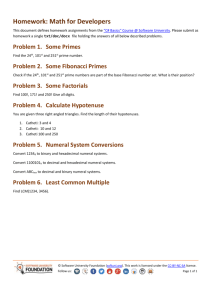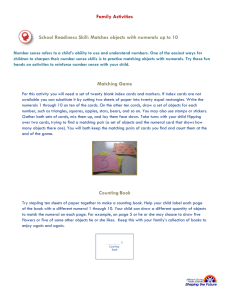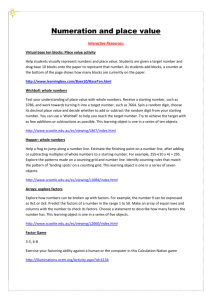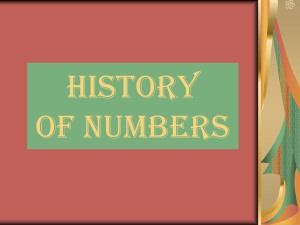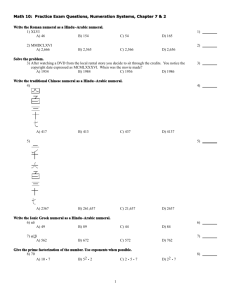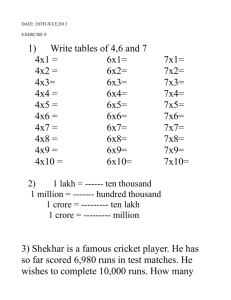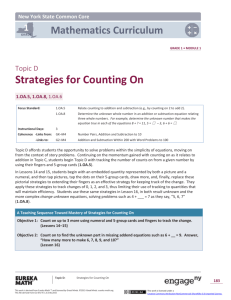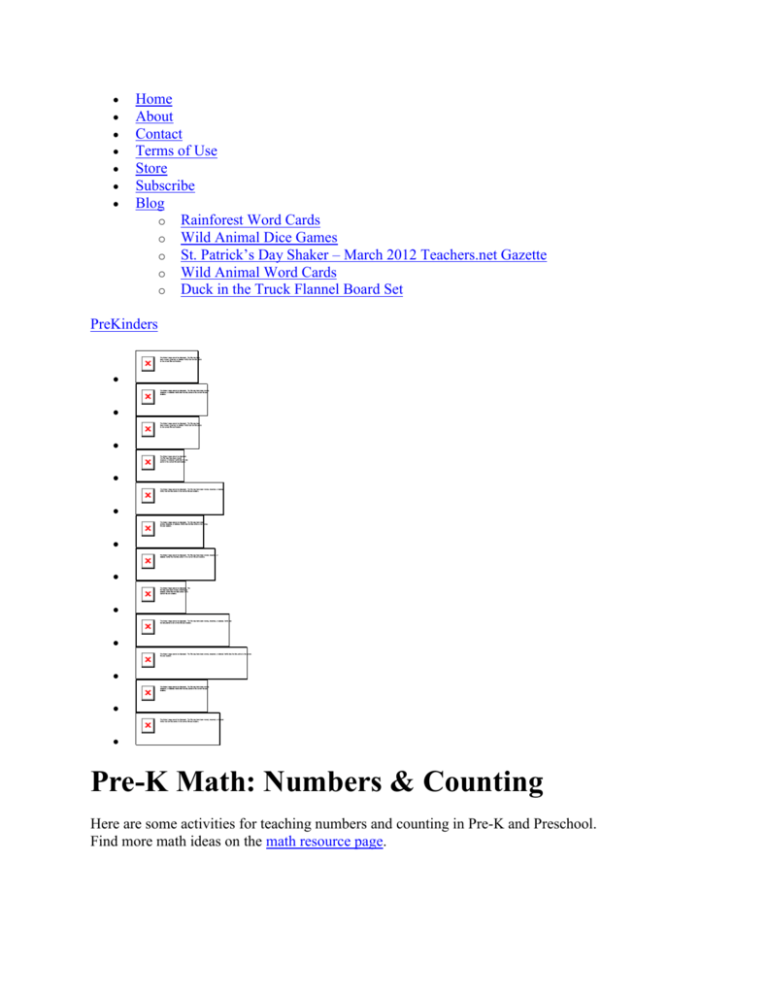
Home
About
Contact
Terms of Use
Store
Subscribe
Blog
o Rainforest Word Cards
o Wild Animal Dice Games
o St. Patrick’s Day Shaker – March 2012 Teachers.net Gazette
o Wild Animal Word Cards
o Duck in the Truck Flannel Board Set
PreKinders
Pre-K Math: Numbers & Counting
Here are some activities for teaching numbers and counting in Pre-K and Preschool.
Find more math ideas on the math resource page.
Books
A list of number books for Pre-K children: Books
Activities
Making Sets
Use index cards for small counting mats. Children count out sets onto each index card. (In this
photo, children were counting sets of 2.)
Junk Box Counting
I used dry erase boards as a counting “mat” for children to place their counters on. I wrote a
numeral on each child’s dry erase board, then had them identify the numeral, and count out that
amount of counters (from the junk boxes) on their board. After I checked their work, they could
erase the number and I wrote a new number on their board. Each child was able to work at their
own pace and at their own level of ability. Some children were working on numbers 1-5 while
others were counting beyond 10.
Dotted Cards
Dotted cards are made with index cards and colored dot stickers. I made a card for each number
1-10, with the numeral written beside the dots. Children count aloud verbally as they place each
math counter on each dot. They use these when they are beginning to learn counting to help them
place the correct amount of math counters on the card.
Fruit Counting
I put sticker dots on disposable plastic plates and covered the middle with clear contact paper.
Each plate has a different amount of dots. Children count the dots on the plate, say the number,
then count out that amount of fruit to place on the plate. Any type of counters can be used if fruit
counters are not available. These are similar to the dotted cards above, except that I did not write
the numeral beside the dots because in this game, the objective was counting and one-to-one
correspondence only, rather than identifying the numeral.
Grid Games
Children roll a game die, identify the number (or amount of dots) on the die, and count out that
amount of game pieces to place on the grid game. They continue playing until the grid is full.
The grid games can be designed to accomodate different skill levels by making more or fewer
grids or spaces on the game and by using teacher-made dice. If I have a child who can count up
to 3, I give that child a die with numerals 0-4 on it, so that they can be more successful than they
would with a 1-6 die, yet also can practice counting higher than 3. Grid games can be made with
stickers, or find printable grid games here.
Path Games
Children roll a game die and count the amount of spaces to move their game piece. Path games
can be designed to accomodate different skills levels in the same way as the grid games.
Count and Match Games
I made this set with posterboard, car stickers, and clear contact paper. There are two cards
representing each number. The children count the cars on each card, and match the cards that
have the same amount of cars. I made sure to place the stickers in different arrangements so that
they wouldn’t appear the same at first glance (they have to actually count them).
Dominoes
Children count and match the amount of dots on the dominoes.
Play Dough Stamps
Children press a number stamp in the play dough and count out that amount of marbles to press
in the play dough. (These Play Dough Stamps came from Lakeshore.)
Drawing Numbered Sets
Children draw simple pictures (rainbows, flowers, suns, balloons, stick people, etc.) to represent
the number. For example, for the number 3, they might draw 3 suns.
Fish Tumble
Children use numeral identification skills and counting skills to put the numeral fish in order on
the blue felt (the pond). I made these by writing numbers on foam fish from the craft store (you
can use any type of foam shape).
Ladybug Game
This is a game I saw at a workshop. It has 2 levels. On one side of the sticks, a numeral is written
with the corresponding amount of ladybugs stamped on the sticks. Children identify the numeral,
then place each ladybug counter on a ladybug on the stick while counting aloud. The flip side of
the stick has the numeral written on it, but is not stamped. More advanced children can use the
unstamped side, then self-check their answer by checking the reverse side.
Counting Airplanes
Each month, we kept track of how many airplanes flew over our playground while we were
outside. Whenever the children saw airplanes outside, we would keep a count in our heads
(usually no more than 3 flew over). Then when we went inside, we would add that many
airplanes to our chart. The children were often spotted at the chart counting how many we had
seen so far.
Number Book
The photo shows a spider counting book we made. The children identified the numeral then
stamped that amount of circles on the page with a bingo marker. They drew the legs and eyes
with a pencil. I always make sure the children are comfortable counting with manipulatives
before doing a number book so that they won’t get frustrated trying to make the book without
mistakes.
Mystery Socks
Children work with a partner to play this game. They will need one sock and 5 flat floral marbles
(the flat marbles work great for math manipulatives because they won’t roll away). One child
places an amount of marbles into the sock. The other child reaches into the sock without peeking,
counts the marbles by feeling them, and says the number. The children can then take the marbles
out of the sock to see if the answer was correct.
Jewel Strings
Jewel strings are strings of colored plastic jewels that are cut into segments with 1 jewel per
string, 2 jewels per string, 3 jewels per string, and so on (through 10). Each child needs one set
of jewel strings with jewels 1-10, and a set of numeral cards 1-10. The children take one jewel
string at a time from their container, count the jewels on the string, and match it to the correct
numeral card.
Numeral Identification Activities
Glitter Numbers
Children trace over the number with their finger and then with glitter glue. We recite Jack
Hartmann’s number writing rhymes (“Math in Motion” CD). Another source for rhymes:
Hubbard’s Cupboard
Sand Boxes
Children practice writing numerals in the sand with their finger. The sand box is just a wooden
box (originally a game came in it) with about a 3-inch rim around it, with enough colored art
sand to cover the bottom.
Stamping Game
Children roll a numeral game die, find the numeral on their paper, and stamp it out. They
continue until they have stamped every numeral.
Number Constellations
I wrote a number on a half sheet of construction paper with a Sharpie. Children sit on the floor,
placing their paper on the carpet, and poke holes through the paper along the lines using a
toothpick. When they are done, they can hold the paper up to the light and see tiny stars in the
shape of their number.
Yarn Numbers
Children trace the numeral with glue, then lay a piece of yarn in the glue to form the number.
Number Bingo
Children listen as numbers are called out. If that number is on their bingo card, they cover it with
a chip or math counter. When a child’s bingo card is full, they call out “Bingo!” We always play
until everyone fills their card.
Connect With Me
Search
My TPT Store
Advertisement
Grab My Button
<div align="center"><a href="htt
Friends
Advertisement
Designed using Thesis WordPress Theme. Website Design by Karen Cox
Copyright © 1999–2012 Karen Cox | All Rights Reserved
Terms of Use | Disclosure Policy | Support This Site
PreKinders is a website for Pre-K and Preschool Teachers - Lessons, Themes, Printables, HandsOn Activities for Early Childhood
< img src="http://pixel.quantserve.com/pixel/p-6ehzATkLbQ7s-.gif" style="display: none;"
border="0" height="1" width="1" alt="Quantcast"/>


